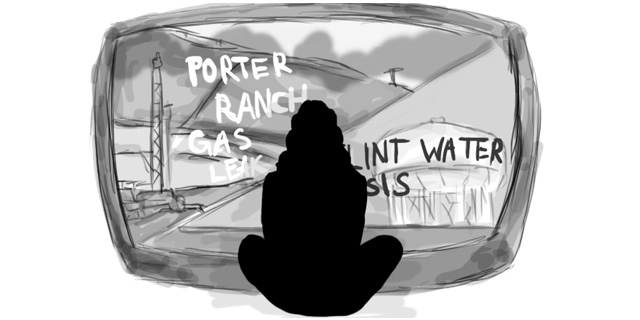
As residents in Flint began noticing contaminated water flowing from their taps, they immediately began protesting and demanding cleaner water. Governor Rick Snyder was notified of the danger and the protests, but dismissed these complaints. The corrosive water from the Flint river caused lead to poison the water supply. As Marlborough students, we direct our attention to environmental issues, like climate change, but do not discuss or acknowledge the water crisis in Flint. It’s acceptable to be ignorant at Marlborough because we all live in the same protected bubble, but we need to use our resources and energies to help others in need.
In March 2013, in order to save money, Flint’s water source was switched from purchased water from the Detroit Department of Water and Sewage to the Flint river. Not only was the water discolored and odorous, but it also contained highly corrosive pollutants that wore down the pipes of the Flint water system. Lead in the outdated pipes was then leached into the water supply, and consumed by thousands of Flint residents.
The water could have been properly treated with an anticorrosive agent or not switched in the first place, or the pipes could have been replaced. However, this was not done because there wasn’t enough funding for the local government to provide safe, clean water.
The awareness about the Flint water crisis amongst students at Marlborough is minimal and the environmental and societal damage isn’t discussed. Marlborough students, including me, associate environmental issues solely with climate change. Our assemblies about the environment only cover global warming and protection of the ozone layer and neglect pollution. The Flint water crisis was never brought up in any M3s or ASMs.
The health consequences of Flint are grave and heartbreaking. Around 9000 children who were exposed to the lead even at low levels are now at a higher risk for brain damage, behavioral problems, and learning disabilities. The exposure has major implications with long-term symptoms that include a lower IQ, shortened attention span, and an increase in violent and antisocial behavior according to Dr. Philip Landrigan, Dean of Global Health at Mount Sinai School of Medicine. Exposure to lead for pregnant women leads to an increased risk of miscarriage, in addition to damage to the developing baby’s nervous system.
Not only does contaminated water deprive residents of Flint of basic necessities, it creates an atmosphere of paranoia amongst residents, by creating a climate of incessant insecurity over the safety of water. A similar environmental disaster occurred in Porter Ranch, as a gas leak, which started on October 2015, polluted the air and residents were immediately evacuated. The gas leak was plugged on February 18, 2016. Both of these incidents were preventable, but why were they handled so differently? Why was Flint put on hold and dismissed by both state and federal officials? While the incidences in Porter Ranch and Flint were both terrible, Porter Ranch was dealt with almost immediately. Porter Ranch’s residents are mostly white and well-off. It took Flint’s situation two years before officials declared a state of emergency, while the affluence of Porter Ranch helped motivate officials to deal with the problems sooner. Due to Flint’s predominantly African-American and low economic population, both the media and state governments prioritized their resources to more well-off white neighborhoods. Racial and economic prejudices have caused state and federal officials to remain biased, putting marginalized people at risk.
It’s easy for us to dismiss the injustice in Flint because we remain protected from these kinds of environmental catastrophes. We live in areas where the wealthy and the white will force city officials to respond. Incidents like Flint should be considered just as urgent as climate change because of the direct effect it has on residents.














